|
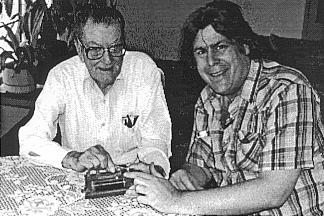
Vernon Furr and Ed Sharpe Examining "The Mighty Atom Crystal Set"
The photos will be replaced when I can find the orig.
these are just screen shots from dithered page maker file.
One evening I purchased a small crystal set that, according
to the label had been manufactured in Phoenix Arizona. Up to this point I was
not aware of any early organized radio production in the state.
Knowing that I wanted to learn more of the history of this radio, I asked as
many questions as I could of the person that I purchased it from. He told me
that he thought that the fellow that owned the company that built it was still
alive.
At this point I went for the telephone book and looked up the name Vernon Furr,
and there it was printed in the book with a telephone number that would finally
answer some of the questions that I had boiling in my mind!
Well, what started out to be a quick investigative phone call, turned into an
interesting two hour informative chat on radio happenings in early Arizona!
Vernon agreed to meet with me the following day so that I might interview him on
tape in his home.
Between the time I had purchased the crystal set and called Vernon, I had also
talked to another friend who had a few crystal sets. Among these he had an
example of "The Mighty Atom" also! I mentioned to him that I knew the
name of the fellow that had manufactured them, and after talking to Vernon, I
called him back to tell him I had indeed made contact with the manufacturer!
That next morning I headed out from the office along with an engineering student
who worked for us part time during the summer. He had an interest in how
communications functioned in the early days, and wanted to meet the fellow who
had built this little crystal set. Armed with a 35 mm camera and a tape
recorder, we set out on our adventure!
I had a very enjoyable chat with Vernon Furr about how the set came about, when
it was built, and about general radio topics from the early days. Here is a
partial transcription of what we talked about.
Ed - Vernon, what got you interested in radio to begin with?
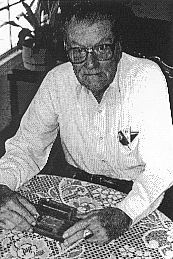
Vernon - I had a crystal set similar to this (he points at the Mighty
Atom) a friend of mine got it some place and I made a copy of it. I also built
other types of radios also, here is a negative of an early tuner and one tube
detector. (See photo of a young Vernon Furr with this apparatus.)
Ed - What time period would this have been?
Vernon - It was before I got married, and before the depression hit out
west here, so I would say in the 20ís.
Ed - When did you start your radio shop?
Vernon - Well I started more or less after I got that crystal set! After
that I got interested in public address systems. The politicians wanted them for
meetings at different places.... I bought some horns, an amplifier and a
condenser microphone from KOY. I paid two hundred and some dollars for them.
Ed - Where did you buy the parts for the radios you manufactured, Vernon?
Vernon - I got some of the parts from Wholesale Electric, and I got the
wire from Electric Rewind in Phoenix.
Ed - When was this radio made, Vernon?
Vernon - This was before the war you know. Hitler was starting his
business but there was not a war for us yet.
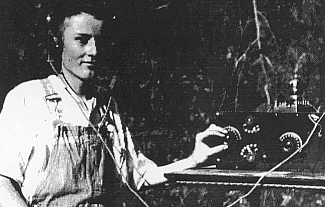
A young Vernon with his home-made tuner and one tube
detector.
Ed - Did you continue to make them during the war?
Vernon - No, I quit before the war.
Ed - How many of these radios did you make and sell?
Vernon - Around 200 or 250, thatís about the size of it.
Ed - I notice that the label says Phoenix, Arizona? But your radio shop
was in Mesa. Why Phoenix?
Vernon - We used Phoenix because it was a bigger town, and I got some of
my help from Phoenix also.
Ed - What did this crystal set sell for?
Vernon - What did I get for those things... A dollar and a half I think..
Ed - What was the cost of the parts to build it?
Vernon - I made a 50% profit.
Ed - On a radio such as this, Vernon, how many stations could you
receive?
Vernon - KOY and KFAD were the only two that would really work; they were
both pretty powerful stations. They had antennas on the buildings. It was before
they had antennas on South Mountain. KFAD later became KTAR. I had a friend
named Andy Anderson, he was the chief engineer at KFAD. I used to go up and see
him and fool around with radios and things with him.
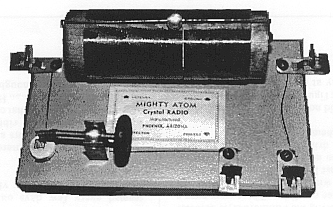
Close up shot of "The Mighty
Atom" Crystal Set, 1936
Ed - So, what was it like having a business during the depression?
Vernon - Things were so hard, you could barely get anything to eat! When
the war came along things got a lot better. In addition to working with radios,
I also worked in theatres as a projectionist.
Ed - What were the radios sold during the depression?
Vernon - Well, Atwater Kent was a real popular one, but there were RCAís
etc..
Ed - When did Furr Radio close?
Vernon - I had a shop on North McDonald in Mesa, and after my wife died,
it was 1950, I got into the projectionists union and went to work at the theatre
full time. In 1950, I had to close the shop, as I was not making enough money to
navigate with.... I am still working as a projectionist at Metrocenter two days
a week!
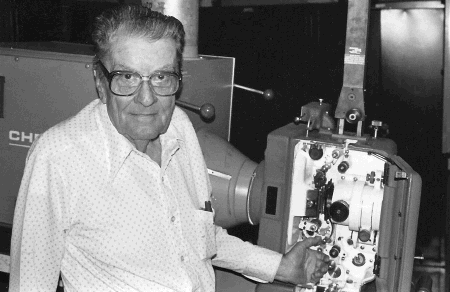
Vernon and his Century Projector at
Metrocenter
Ed - You are still working at almost 84 years old?!!
Vernon - As long as I can thread a machine I still will be working! I donít
really want too many hours, but I enjoy it.
~~~~~
After some more conversation, Vernon took us to a shed behind his house in Mesa,
where he said "I have some of those radios over in the corner there."
Climbing over the piles of old 50ís radio chassis, gutted record changers and
remains of televisions, I got to the corner of the room.
What I saw when I uncovered the box of radios, was as I had imagined what I
would find when I let my imagination wander that evening before I fell asleep.
There before me was a treasure!
Feeling like Carter when he discovered the treasure of Tutankamenís tomb, I
knew that we were becoming archaeologists unearthing fragments of a past era of
radio history. A whole box of MIGHTY ATOM crystal sets! Judging from the amount
of dust and spiders around there, it seemed as though they had been there since
the date of manufacture!
After some digging and shuffling Vernon and I passed the box over the piles of
radio chassis and out the door into the sunlight. The final count we came up
with was 17 radios. Some were missing the Philmore style detector but were in
nice condition. There were even a few that were wrapped in paper so tightly that
they looked just like the day they were made! There was also an assortment of
wood bases that had been drilled, but never had had any parts put on them.
I really did not need 17 of the same model crystal set, but figured that if I
did not retrieve them they may at some point find their way into the trash bin.
After more discussion and more looking around, we decided to call it a day as it
was rather hot in the shed!
It seems from the remaining stock of radios, they came in yellow, red and forest
green. We ended up with one yellow radio, nine red and seven green models.
Examples of each color are on display at the Southwest Museum of Electricity and
Communications in Phoenix.
Unfortunately only three weeks after I had the pleasure of meeting Vernon Furr
he passed away as the result of a massive stroke. He loved talking about the the
old days of radios, sound systems, and theatres and it seemed every few days out
of that three weeks he was either over visiting us or we were visiting him.
He gave us a lot of interesting insight on repair of radios, amplifiers and a
most novel way to make a crinkled ribbon for ribbon microphones! It was sad that
on June 19, 1988, all of this came to an end..... He will be missed by those of
use lucky enough to have known him.... --EAS.
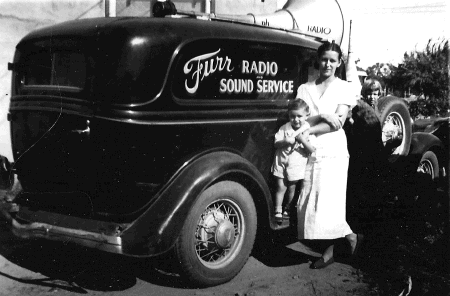
Vernon's wife and child alongside
his early service truck. Note the large Horn atop the truck!
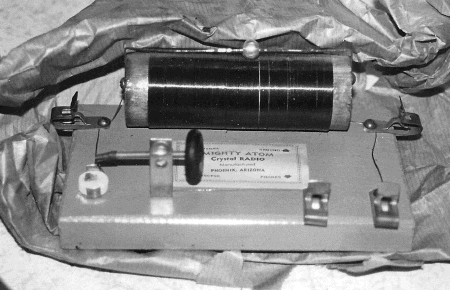
Radio as found in the
wrapping Vernon had placed it in ages ago... |







